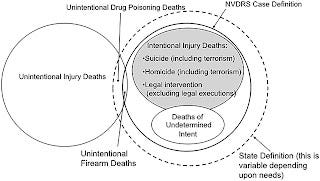The CDC's "National Violent Death Reporting System" posts inaccurate police killings figures (Updated)

Earlier this month it was revealed that the Centers for Disease Control and Prevention's (CDC) National Violent Death Reporting System (NVDRS) now includes all fifty states.
"The NVDRS claims to be a surveillance system that pulls together data on violent deaths in all 50 states including information about homicides, such as homicides perpetrated by an intimate partner (e.g., boyfriend, girlfriend, wife, husband), child abuse and neglect or child abuse homicides, suicides, and deaths where individuals are killed by law enforcement in the line of duty. "
As you will see the NVDRS's "surveillance system" for Americans killed by police officers raises many questions.
Clicking on the only database available "Violent Deaths 2003-2015" reveals a disturbing fact about police officer involved deaths.
Researchers have only one choice, which is to go to Section 3 and tick the box marked "victim injured by law enforcement officer" and click the year you want to view. And as you will see the results are highly questionable.
The CDC claims that in 2015 only 358 citizens were killed by law enforcement. The same is true for the past six years. (See the results below.)
358 citizens killed (2015)
267 citizens killed (2014)
212 citizens killed (2013)
210 citizens killed (2012)
168 citizens killed (2011)
173 citizens killed (2010)
If you totaled up the numbers for those years, the number of people the CDC claims have been killed by police is 1388. Which is just above the average number of Americans killed by police each year.
Updated 10/5:
CDC's gun violence data is "unreliable"
According to a study done by FiveThirtyEight, the CDC's gun violence data should be be treated as “unstable and potentially unreliable.”
The gun injury estimate is one of several categories of CDC data flagged with an asterisk indicating that, according to the agency’s own standards, it should be treated as “unstable and potentially unreliable.” In fact, the agency’s 2016 estimate of gun injuries is more uncertain than nearly every other type of injury it tracks.
"An analysis performed by FiveThirtyEight and The Trace, a nonprofit news organization covering gun violence in America, found that the CDC’s report of a steady increase in nonfatal gun injuries is out of step with a downward trend we found using data from multiple independent public health and criminal justice databases."
"Over a dozen public health researchers reviewed The Trace and FiveThirtyEight’s analysis and said that the inaccuracy of the CDC gun injury data has serious implications for the national-level understanding of gun violence."
According to a report by Persuade Me Politics, police killings are much higher than what the NVDRS has reported.

image credit: Geek Media
The first chart shows 385 police killings for January-May in 2015, by the end of 2015, the total had reached 995 people. Which was very similar to the 963 people killed by police in 2016.

A website called Cop Crisis claims that 1171 were killed by police in 2016 and 1194 were killed in 2017.
The UK Guardian's "The Counted" series revealed that on average more than one thousand Americans are killed by police each year. Another website called Fatal Encounters is also at odds with the NVDR's database.
A new study released by the National Institutes of Health claims U.S. police kill an average of 3 men a day.
"Police kill, on average, 2.8 men per day. Police were responsible for about 8% of all homicides with adult male victims between 2012 and 2018. Black men's mortality risk is between 1.9 and 2.4 deaths per 100 000 per year, Latino risk is between 0.8 and 1.2, and White risk is between 0.6 and 0.7."
Conclusions: "Police homicide risk is higher than suggested by official data."
Fatal Encounters "Visualizations" section reveals a steady uptick of officer involved shootings dating back to 2004 and includes a disturbing map detailing the number of people killed by police in each state!
A 2017 study released by JAMA Surgery found that from 2006 to 2012, there were approximately 51,000 emergency department visits per year for patients injured by law enforcement.
With so many sources contradicting the CDC the question remains, is the CDC's report spanning twelve years, intentionally misleading?
Before you answer that, I will leave you with this reassuring message from the CDC.
"CDC’s Injury Center works to protect the safety of everyone, every day; this includes preventing homicide and suicide and their adverse health consequences to families and communities."
Yeah, good luck with that.
What about the adverse health consequences of being injured or killed by a police officer? Don't worry it will never happen, the CDC would never let the public see those figures.


